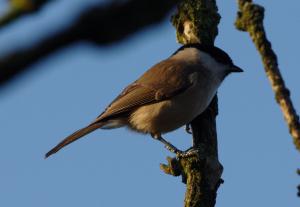Marsh Tit Poecile palustris
Austin Dobbs in The Birds of Nottinghamshire(1975) said that the Marsh Tit was a fairly common resident, being more common than the Coal Tit. He estimated the density at around a pair of birds to a 10 acre (c4 hectares) wood. In the BWP (1993) Marsh Tit densities are given as 0.5 - 6.5 hectares per pair in deciduous woodland, depending on habitat quality.
Marsh Tits have declined by 38% in the years 1980-2005{BTO/JNCC Breeding birds in the wider countryside }
Broughton, Richard K et al {Marsh Tit (Poecile palustris) territories in a British broad-leaved wood, Ibis, October 2006} carried out a survey in Monks Wood which showed that there Marsh Tits preferred mature trees with a shrub layer underneath but eschewed areas of the wood with young or immature trees. It is also thought that by specialising in using the shrub layer, they can avoid too much competition with Blue Tits and Great Tits.
Several researchers have mentioned the increase in deer has having a negative effect on the understory of woodland by their browsing. Also the closing of the canopy in plantation woods shading out the understory and the clearance of shrubs to provide open areas for environmental reasons, to encourage butterflies and woodland flowers for instance could be other factors.
Siriwardena {Ibis April 2006} using data from the British Trust for Ornithology's Common Birds Census (CBC) found that potential avian nest predators had little or no effect on populations of Marsh Tit. Siriwardena {Avian nest predation, competition and the decline of British Marsh Tits, Ibis April 2006} also thought that the Marsh Tit decline was because of its habitat degradation. Grey Squirrels were excluded from both works.

Identification
The Marsh Tit has a shiny black cap whereas the Willow Tit has a dull black cap. Why? Benard Tucker looked at the head feathers of both species very carefully using a microscope and found that the feather barbules are closer together and straighter on the Marsh Tit than on the Willow Tit giving the Marsh Tit that glossy head appearance.
The best literature for Marsh Tit/Willow Tit separation must be the paper by Richard Broughton published in British Birds (2009).
Distribution
Prefers mature woods with some undergrowth and especially a shrub layer. They are still common in Rufford country park, Clumber park and Sherwood forest park, lesser so in Colwick Park, Bramcote wood and Wollaton Park. At Attenborough nature reserve they are present most years in the delta wood area.
Any criticisms, corrections or comments to the author Derek Huskisson

This work is licensed under a Creative Commons Attribution-Noncommercial-Share Alike 2.0 UK: England & Wales License.
